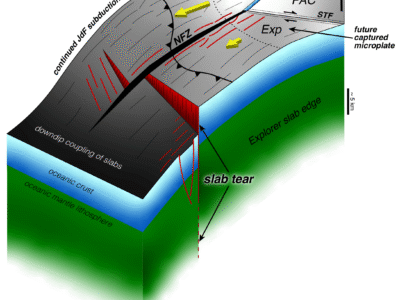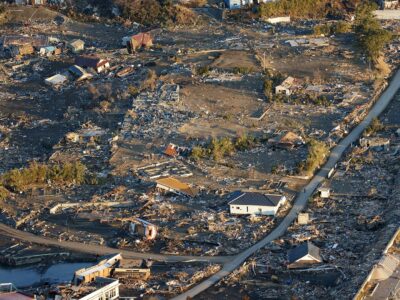
Liz Chamberlain and Steve Goodbred, two sedimentologists from Vanderbilt University, were traipsing around coastal Bangladesh in March 2018 when they saw the sand dikes. Chamberlain and Goodbred had come to Bangladesh to investigate how fast rivers meander, or shift, in the coastal part of the Ganges-Brahmaputra Delta.
Their research team, also consisting of Goodbred’s graduate student Rachel Bain, and Abdullah Al Nahian and Mahfuzur Rahman from Dhaka University, was taking sediment samples from loops in the many rivers that cross the lower delta plain. They would use these samples to date the sediments left behind as the rivers shifted.
Midway through the trip, they came across a large pond that had just been dug for storing fresh water. On the flank of the pond, there were vertical sand dikes up to 30–40 cm wide, cutting through the horizontal layers of sediments. The team already knew that earthquakes often left behind injections of sand through sediment layers. The shaking from an earthquake separates the sand grains and increases pressure until it erupts like a sand volcano, forming a “seismite.” But these seismites were far from the tectonically active parts of Bangladesh and India that could’ve been the source of the earthquake, and the size of the dikes so far from the epicenter suggested it had been a large earthquake.

Chamberlain and Goodbred had been drawn to the local area by a broad abandoned river channel that was clearly visible in a digital elevation model as a low-elevation curve. The abandoned channel was about 1.5 km wide and used for rice cultivation. They had spent the morning in the hot sun surveying the abandoned channel, and it was late in the day when the team discovered the seismites in the freshly dug pond walls. With the assistance of Al Nahian and Rahman as translators, Goodbred asked the owner of the pond to not fill it with water overnight so they could continue their investigation.
When the team realized just how important this finding was and the need to immediately document it before the pond was inundated, they contacted us (Lamont-Doherty Earth Observatory geophysicist Michael S. Steckler and Christoph von Hagke, professor at Salzburg University). As experts in geophysics, structural geology and neotectonics—the study of the contemporary motions and deformations of Earth’s crust—we have more experience with the tectonics of the region and conditions for the development of sand dikes. It is not easy to distinguish a seismite from other sand dikes. For example, sand dikes can also be caused by varying degrees of overburden pressure or excess pore water pressure at a certain depth.

To recognize whether these formations could really be seismites, it was necessary to document the structure as well as possible. The first task was to immediately improvise a basic research design. The next day, the field team returned to the pond and documented all aspects that could help in understanding both the fluvial (associated with the river) and seismic history of the site—sediment texture, dike dimensions and orientation, optically stimulated luminescence samples to date the sediments and more.
We tested the hypothesis that these really were seismites from all sides, investigating the orientation of the sand veins and any external topographic features that could have played a role. Only when all other possible explanations were shown to be inadequate were we sure that they were seismites. After the field work was completed, we looked at potential sources for the earthquake, the stress field of the delta plain and empirical relationships from prior research on dike width, distance to origin and earthquake magnitude.

We found that the likely potential sources of the earthquake were over 180 km away. Investigating the size of the sand dikes with the distance to the earthquake, we concluded that the likely size of the earthquake was a magnitude of 7–8.
The ages of the samples at the sand dikes and the abandoned river channel, based on the optically stimulated luminescence, showed that both channel abandonment and dike formation occurred at the same time, around 2,500 years ago. The large scale of the channel, along with the finding of a similar channel abandoned at the same time about 85 km downstream, suggests that this was a major shift, known as an avulsion, of the Ganges River. Rivers in deltas deposit sediments that build up their elevation with time. Eventually, they avulse to a new lower elevation pathway. For example, the Mississippi River has avulsed seven times over the Holocene. The coincidence of timing of the Ganges River avulsion and the earthquake suggests that the avulsion was triggered by the earthquake.
This discovery is the first confirmation that earthquakes can drive avulsions of immense rivers in deltas, which could spell a potential cascading hazard in susceptible locations.

This article was adapted from a “Behind the Paper” post on Springer Nature.



